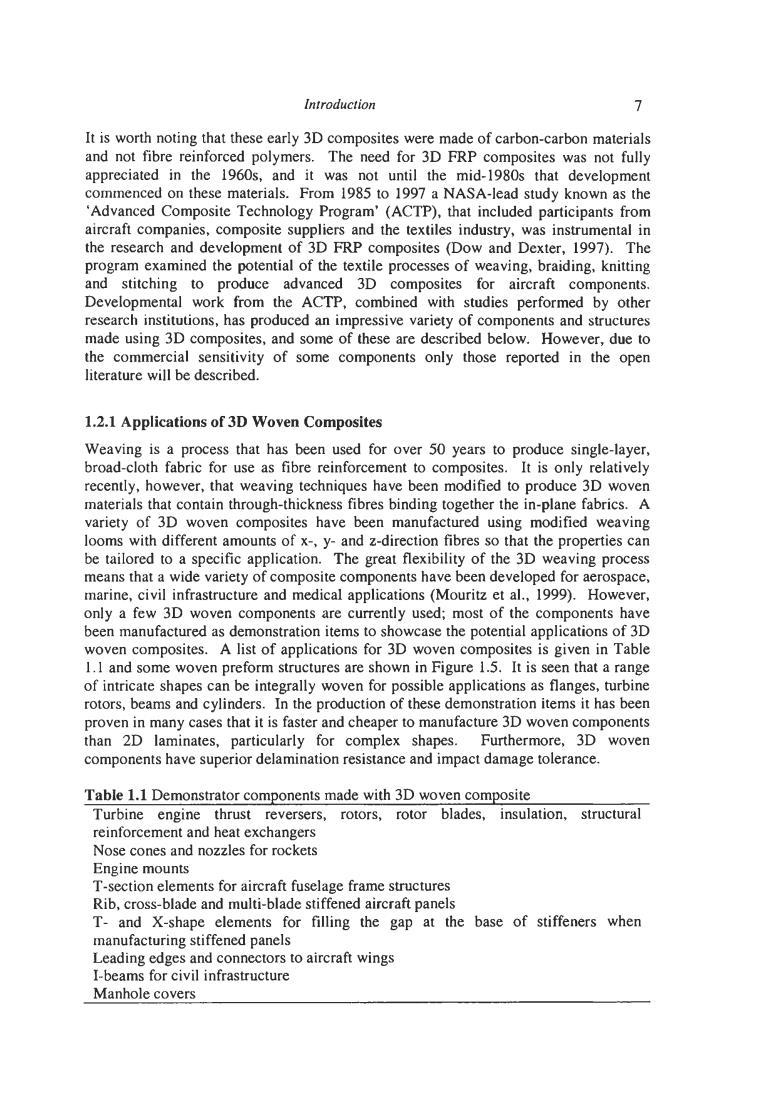正在加载图片...

Introduction 7 It is worth noting that these early 3D composites were made of carbon-carbon materials and not fibre reinforced polymers.The need for 3D FRP composites was not fully appreciated in the 1960s,and it was not until the mid-1980s that development commenced on these materials.From 1985 to 1997 a NASA-lead study known as the 'Advanced Composite Technology Program'(ACTP),that included participants from aircraft companies,composite suppliers and the textiles industry,was instrumental in the research and development of 3D FRP composites (Dow and Dexter,1997).The program examined the potential of the textile processes of weaving,braiding,knitting and stitching to produce advanced 3D composites for aircraft components. Developmental work from the ACTP,combined with studies performed by other research institutions,has produced an impressive variety of components and structures made using 3D composites,and some of these are described below.However,due to the commercial sensitivity of some components only those reported in the open literature will be described. 1.2.1 Applications of 3D Woven Composites Weaving is a process that has been used for over 50 years to produce single-layer, broad-cloth fabric for use as fibre reinforcement to composites.It is only relatively recently,however,that weaving techniques have been modified to produce 3D woven materials that contain through-thickness fibres binding together the in-plane fabrics.A variety of 3D woven composites have been manufactured using modified weaving looms with different amounts of x-,y-and z-direction fibres so that the properties can be tailored to a specific application.The great flexibility of the 3D weaving process means that a wide variety of composite components have been developed for aerospace, marine,civil infrastructure and medical applications (Mouritz et al.,1999).However, only a few 3D woven components are currently used;most of the components have been manufactured as demonstration items to showcase the potential applications of 3D woven composites.A list of applications for 3D woven composites is given in Table 1.1 and some woven preform structures are shown in Figure 1.5.It is seen that a range of intricate shapes can be integrally woven for possible applications as flanges,turbine rotors,beams and cylinders.In the production of these demonstration items it has been proven in many cases that it is faster and cheaper to manufacture 3D woven components than 2D laminates,particularly for complex shapes.Furthermore,3D woven components have superior delamination resistance and impact damage tolerance Table 1.1 Demonstrator components made with 3D woven composite Turbine engine thrust reversers,rotors,rotor blades,insulation,structural reinforcement and heat exchangers Nose cones and nozzles for rockets Engine mounts T-section elements for aircraft fuselage frame structures Rib,cross-blade and multi-blade stiffened aircraft panels T-and X-shape elements for filling the gap at the base of stiffeners when manufacturing stiffened panels Leading edges and connectors to aircraft wings I-beams for civil infrastructure Manhole coversIntroduction 7 It is worth noting that these early 3D composites were made of carbon-carbon materials and not fibre reinforced polymers. The need for 3D FRP composites was not fully appreciated in the 1960s, and it was not until the mid-1980s that development commenced on these materials. From 1985 to 1997 a NASA-lead study known as the ‘Advanced Composite Technology Program’ (ACTP), that included participants from aircraft companies, composite suppliers and the textiles industry, was instrumental in the research and development of 3D FRP composites (Dow and Dexter, 1997). The program examined the potential of the textile processes of weaving, braiding, knitting and stitching to produce advanced 3D composites for aircraft components. Developmental work from the ACTP, combined with studies performed by other research institutions, has produced an impressive variety of components and structures made using 3D composites, and some of these are described below. However, due to the commercial sensitivity of some components only those reported in the open literature will be described. 1.2.1 Applications of 3D Woven Composites Weaving is a process that has been used for over 50 years to produce single-layer, broad-cloth fabric for use as fibre reinforcement to composites. It is only relatively recently, however, that weaving techniques have been modified to produce 3D woven materials that contain through-thickness fibres binding together the in-plane fabrics. A variety of 3D woven composites have been manufactured using modified weaving looms with different amounts of x-, y- and z-direction fibres so that the properties can be tailored to a specific application. The great flexibility of the 3D weaving process means that a wide variety of composite components have been developed for aerospace, marine, civil infrastructure and medical applications (Mouritz et al., 1999). However, only a few 3D woven components are currently used; most of the components have been manufactured as demonstration items to showcase the potential applications of 3D woven composites. A list of applications for 3D woven composites is given in Table 1.1 and some woven preform structures are shown in Figure 1.5. It is seen that a range of intricate shapes can be integrally woven for possible applications as flanges, turbine rotors, beams and cylinders. In the production of these demonstration items it has been proven in many cases that it is faster and cheaper to manufacture 3D woven components than 2D laminates, particularly for complex shapes. Furthermore, 3D woven components have superior delamination resistance and impact damage tolerance. Table 1.1 Demonstrator components made with 3D woven composite Turbine engine thrust reversers, rotors, rotor blades, insulation, structural reinforcement and heat exchangers Nose cones and nozzles for rockets Engine mounts T-section elements for aircraft fuselage frame structures Rib, cross-blade and multi-blade stiffened aircraft panels T- and X-shape elements for filling the gap at the base of stiffeners when manufacturing stiffened panels Leading edges and connectors to aircraft wings I-beams for civil infrastructure Manhole covers